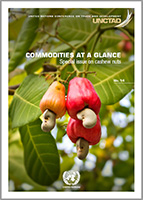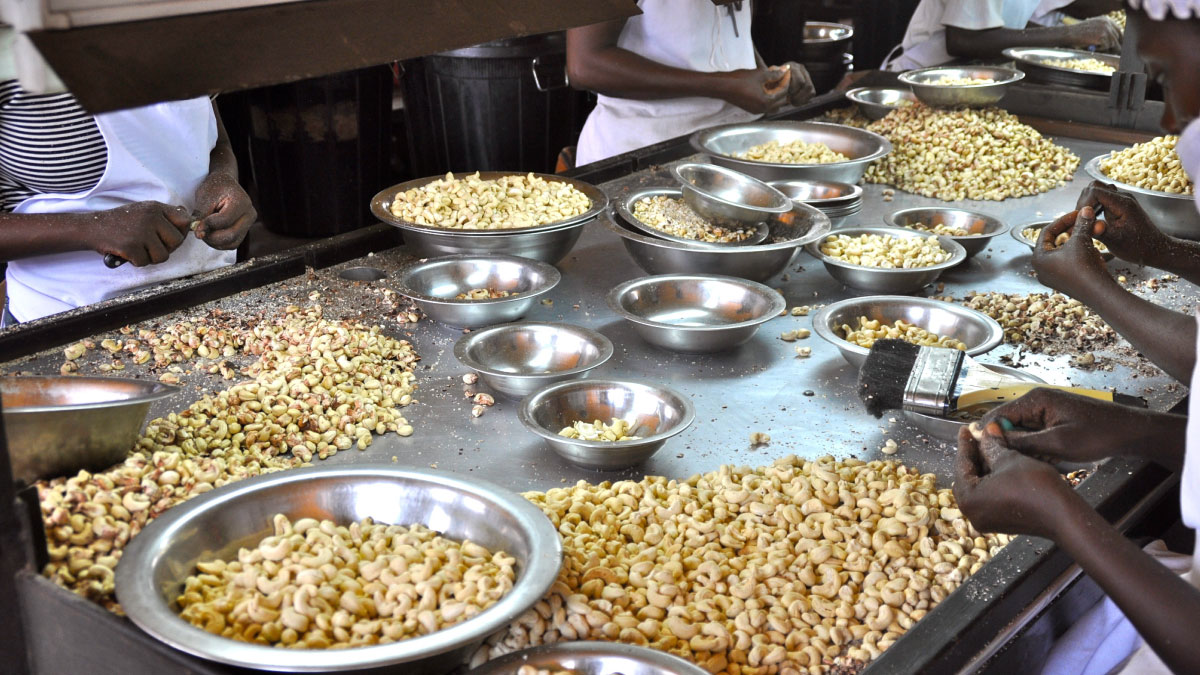 UNCTAD (2021) Commodities at a Glance: Special issue on cashew nuts, April 2021, 41 pp.
UNCTAD (2021) Commodities at a Glance: Special issue on cashew nuts, April 2021, 41 pp.
Cashew trees thrive in tropical climates. Africa produced more than half of the global raw cashew nut output in the period 2014–2018, with West Africa and East Africa accounting for average annual production shares of 42% and 10%, respectively. Asia accounted for an average annual share of 43% and Latin America and the Caribbean for the remaining 5 %. A total of 63% of global raw cashew nut production growth in the period 2000-2018 took place in Africa.
All 46 countries producing cashew nuts on a significant scale are developing countries, with 18 of theleast developed countries among them. However, not all cashew-growing countries participate in the global value chain in an equal manner. In particular, the majority of cashew nuts grown in Africa are exported as raw nuts before deshelling, which takes place mainly in two countries: India and Viet Nam. Two figures illustrate this pattern: Africa accounted for 90% of global raw cashew nut exports in 2014-18 while India and Viet Nam accounted for a combined share of 98% of global raw cashew nut imports during the same period.
Countries that grow cashew nuts but do not process them on a significant scale retain only a small share of the value created in the global cashew market. In these countries, value addition in the cashew sector holds significant potential to contribute to the achievement of the Sustainable Development Goals (SDGs) through poverty reduction, job creation and rural development. In addition, the commercialization of cashew by-products, which are often discarded as agricultural waste, can help diversify revenue sources and generate more value, employment and business opportunities in communities involved in cashew production and/or processing.
This report takes stock of the global cashew market and gives an overview of cashew production, trade patterns and policies. It also highlights opportunities for the cashew sector to foster value addition and diversification in cashew-growing countries, and its potential contribution to the achievement of the SDGs.
The report is divided into five chapters.
- The first chapter covers the historical background of the global cashew market and contains a botanical characterization of the cashew tree.
- The growth of cashew trees, the uses of cashew nuts and the various by-products are highlighted in chapter 2.
- Cashew production, trade patterns and prices are reviewed in chapter 3.
- An analysis of policy options and opportunities to stimulate development and value addition in the cashew sector is contained in chapter 4.
- Finally, a conclusion is provided in chapter 5.
Better policies needed
While the backbone of the African cashew industry must be a stable supply of high-quality raw nuts, the report says processors also need a policy environment “that enables them to operate with competitive transformation costs and facilitates access to the main export markets.”Policies aimed at supporting the cashew sector in African nations must therefore consider the entire
cashew value chain: production, processing and trade. According to the report, this would include:
- Ensuring farmers have access to quality seedlings, technological know-how and market information.
- Increasing training for farmers on entrepreneurship and farm management, including harvest and post-harvest practices.
- Supporting public research that helps identify agricultural practices and technologies that work best in local environmental and economic conditions.
- Improving rural infrastructure, including secondary roads, to better connect cashew farms and processing sites.
- Facilitating market entry through technical skills development and better access to market information.
- Strengthening capacity among cashew processors to meet quality standards in prospective foreign markets.
- Promoting the development of cashew byproducts, such as beverages based on cashew apples, which are normally discarded as waste.
- Fostering cooperation between cashew-growing regions to improve market stability, limit supply bottlenecks and reduce incentives for cross-border smuggling.
UNCTAD Productive Capacities Index tracks how well countries have developed their productive capacities, allowing policymakers to trace their country’s performance over time.


No comments:
Post a Comment